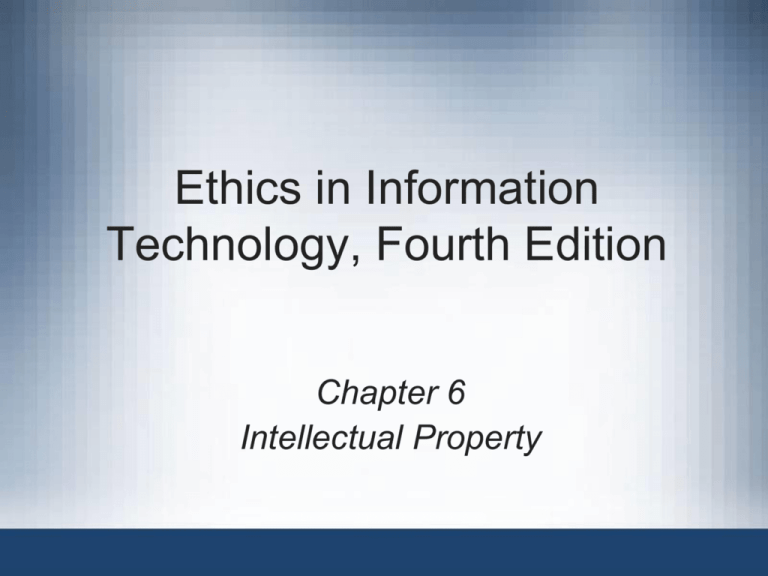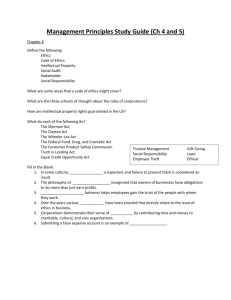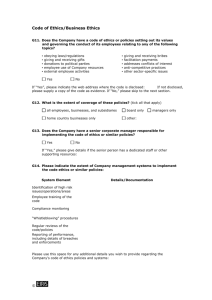Ethics in Information Technology
advertisement

Ethics in Information Technology, Fourth Edition Chapter 6 Intellectual Property Objectives • As you read this chapter, consider the following questions: – What does the term intellectual property encompass, and why are organizations so concerned about protecting intellectual property? – What are the strengths and limitations of using copyrights, patents, and trade secret laws to protect intellectual property? – What is plagiarism, and what can be done to combat it? Ethics in Information Technology, Fourth Edition 2 Objectives (cont’d.) – What is reverse engineering, and what issues are associated with applying it to create a look-alike of a competitor’s software program? – What is open source code, and what is the fundamental premise behind its use? – What is the essential difference between competitive intelligence and industrial espionage, and how is competitive intelligence gathered? – What is cybersquatting, and what strategy should be used to protect an organization from it? Ethics in Information Technology, Fourth Edition 3 What Is Intellectual Property? • Term used to describe works of the mind – Distinct and “owned” or created by a person or group • Copyright law – Protects authored works • Patent law – Protects inventions • Trade secret law – Helps safeguard information critical to an organization’s success Ethics in Information Technology, Fourth Edition 4 Copyrights • Established in the U.S. Constitution – Article I, Section 8, Clause 8 • Grants creators of original works the exclusive right to: – – – – – Distribute Display Perform Reproduce work Prepare derivative works based upon the work • Author may grant exclusive right to others Ethics in Information Technology, Fourth Edition 5 Copyrights (cont’d.) • Copyright term – Copyright law guarantees developers the rights to their works for a certain amount of time • Sonny Bono Copyright Term Extension Act – Created after 1/1/78, life of the author plus 70 years – Created but not published or registered before 1/1/78, life of the author plus 70 years; no expiration before 12/31/2004 – Created before 1978 still in original or renewable term of copyright, 95 years from the date the copyright was originally secured Ethics in Information Technology, Fourth Edition 6 Copyrights (cont’d.) • Types of work that can be copyrighted – – – – – – – – Architecture Art Audiovisual works Choreography Drama Graphics Literature Motion pictures Ethics in Information Technology, Fourth Edition 7 Copyrights (cont’d.) • Types of work that can be copyrighted (cont’d.) – – – – – – Music Pantomimes Pictures Sculptures Sound recordings Other intellectual works: • As described in Title 17 of U.S. Code Ethics in Information Technology, Fourth Edition 8 Copyrights (cont’d.) • Must fall within one of the preceding categories • Must be original – Evaluating originality can cause problems • Fair use doctrine – Allows portions of copyrighted materials to be used without permission under certain circumstances – Maintains balance between protecting an author’s rights and enabling public access to copyrighted works – Factors to consider when evaluating the use of copyrighted material Ethics in Information Technology, Fourth Edition 9 Copyrights (cont’d.) • Fair use doctrine factors include: – – – – Purpose and character of the use Nature of the copyrighted work Portion of the copyrighted work used Effect of the use upon the value of the copyrighted work – Key concept: an idea cannot be copyrighted, but the expression of an idea can be Ethics in Information Technology, Fourth Edition 10 Copyrights (cont’d.) • Copyright infringement – Copy substantial and material part of another’s copyrighted work – Without permission • Software copyright protection – Raises many complicated issues of interpretation – Copyright law should not be used to inhibit interoperability between the products of rival vendors Ethics in Information Technology, Fourth Edition 11 Copyrights (cont’d.) • The Prioritizing Resources and Organization for Intellectual Property (PRO-IP) Act of 2008 – Increased enforcement and substantially increased penalties for infringement • General Agreement on Tariffs and Trade (GATT) – Trade agreement between 117 countries – Created World Trade Organization (WTO) to enforce – Despite GATT, copyright protection varies greatly from country to country Ethics in Information Technology, Fourth Edition 12 Copyrights (cont’d.) • The WTO and the WTO TRIPS Agreement (1994) – Many nations recognize that intellectual property has become increasingly important in world trade – Established minimum levels of protection that each government must provide to the intellectual property of members – Covers copyright, patents, and trade secrets Ethics in Information Technology, Fourth Edition 13 Copyrights (cont’d.) • World Intellectual Property Organization (WIPO) – Agency of the United Nations – Advocates for the interests of intellectual property owners – WIPO Copyright Treaty provides additional copyright protections for electronic media Ethics in Information Technology, Fourth Edition 14 Copyrights (cont’d.) Ethics in Information Technology, Fourth Edition 15 Copyrights (cont’d.) • Digital Millennium Copyright Act (DMCA) – Civil and criminal penalties included – Governs distribution of tools and software that can be used to circumvent technological measures used to protect copyrighted works – Provides safe harbors for ISPs whose customers/subscribers may be breaking copyright laws • ISP must comply with “notice and takedown procedures” that grant copyright holders a process to halt access to alleged infringing content Ethics in Information Technology, Fourth Edition 16 Patents • Grant of property right to inventors • Issued by the U.S. Patent and Trademark Office (USPTO) • Permits an owner to exclude the public from making, using, or selling the protected invention • Allows legal action against violators • Prevents independent creation as well as copying • Extends only to the United States and its territories and possessions Ethics in Information Technology, Fourth Edition 17 Patents (cont’d.) • Applicant must file with the USPTO – USPTO searches prior art – Takes an average of 35.3 months from filing an application until application is issued as a patent or abandoned • Prior art – Existing body of knowledge – Available to a person of ordinary skill in the art Ethics in Information Technology, Fourth Edition 18 Patents (cont’d.) • An invention must pass four tests – – – – Must be in one of the five statutory classes of items Must be useful Must be novel Must not be obvious to a person having ordinary skill in the same field • Items cannot be patented if they are: – Abstract ideas – Laws of nature – Natural phenomena Ethics in Information Technology, Fourth Edition 19 Patents (cont’d.) • Patent infringement – Making unauthorized use of another’s patent – No specified limit to the monetary penalty • Software patent – Protects feature, function, or process embodied in instructions executed on a computer • 20,000 software-related patents per year have been issued since the early 1980s • Some experts think the number of software patents being granted inhibits new software development Ethics in Information Technology, Fourth Edition 20 Patents (cont’d.) • Before obtaining a software patent, do a patent search • Software Patent Institute is building a database of information • Software cross-licensing agreements – Large software companies agree not to sue each other over patent infringements – Small businesses have no choice but to license patents if they use them • Average patent lawsuit costs $3 - $10 million Ethics in Information Technology, Fourth Edition 21 Patents (cont’d.) • Defensive publishing – – – – – – Alternative to filing for patents Company publishes a description of the innovation Establishes the idea’s legal existence as prior art Costs mere hundreds of dollars No lawyers Fast • Patent troll firm – Acquires patents with no intention of manufacturing anything; instead, licensing the patents to others Ethics in Information Technology, Fourth Edition 22 Patents (cont’d.) • Standard is a definition or format – Approved by recognized standards organization or accepted as a de facto standard by the industry – Enables hardware and software from different manufacturers to work together • Submarine patent – Patented process/invention hidden within a standard – Does not surface until standard is broadly adopted Ethics in Information Technology, Fourth Edition 23 Patents (cont’d.) • Patent farming involves: – Influencing a standards organization to make use of a patented item without revealing the existence of the patent – Demanding royalties from all parties that use the standard Ethics in Information Technology, Fourth Edition 24 Trade Secrets • Trade secret – – – – – – Business information Represents something of economic value Requires an effort or cost to develop Some degree of uniqueness or novelty Generally unknown to the public Kept confidential • Information is only considered a trade secret if the company takes steps to protect it Ethics in Information Technology, Fourth Edition 25 Trade Secrets (cont’d.) • Trade secret law has a few key advantages over patents and copyrights – – – – No time limitations No need to file an application Patents can be ruled invalid by courts No filing or application fees • Law doesn’t prevent someone from using the same idea if it is developed independently • Trade secret law varies greatly from country to country Ethics in Information Technology, Fourth Edition 26 Trade Secret Laws • Uniform Trade Secrets Act (UTSA) – Established uniformity across the states in area of trade secret law – Computer hardware and software can qualify for trade secret protection • The Economic Espionage Act (EEA) of 1996 – Penalties of up to $10 million and 15 years in prison for the theft of trade secrets Ethics in Information Technology, Fourth Edition 27 Employees and Trade Secrets • Employees are the greatest threat to trade secrets • Unauthorized use of an employer’s customer list – Customer list is not automatically considered a trade secret – Educate workers about the confidentiality of lists • Nondisclosure clauses in employee’s contract – Enforcement can be difficult – Confidentiality issues are reviewed at the exit interview Ethics in Information Technology, Fourth Edition 28 Employees and Trade Secrets (cont’d.) • Noncompete agreements – Protect intellectual property from being used by competitors when key employees leave – Require employees not to work for competitors for a period of time – Wide range of treatment on noncompete agreements among the various states Ethics in Information Technology, Fourth Edition 29 Key Intellectual Property Issues • Issues that apply to intellectual property and information technology – – – – – – Plagiarism Reverse engineering Open source code Competitive intelligence Trademark infringement Cybersquatting Ethics in Information Technology, Fourth Edition 30 Plagiarism • Stealing someone’s ideas or words and passing them off as one’s own • Many students: – Do not understand what constitutes plagiarism – Believe that all electronic content is in the public domain • Plagiarism is also common outside academia • Plagiarism detection systems – Check submitted material against databases of electronic content Ethics in Information Technology, Fourth Edition 31 Plagiarism (cont’d.) Ethics in Information Technology, Fourth Edition 32 Plagiarism (cont’d.) • Steps to combat student plagiarism – Help students understand what constitutes plagiarism and why they need to cite sources – Show students how to document Web pages – Schedule major writing assignments in portions due over the course of the term – Tell students that instructors are aware of Internet paper mills and plagiarism detection services – Incorporate detection into an antiplagiarism program Ethics in Information Technology, Fourth Edition 33 Reverse Engineering • Process of taking something apart in order to: – Understand it – Build a copy of it – Improve it • Applied to computer: – Hardware – Software • Convert a program code to a higher-level design • Convert an application that ran on one vendor’s database to run on another’s Ethics in Information Technology, Fourth Edition 34 Reverse Engineering (cont’d.) • Compiler – Language translator – Converts computer program statements expressed in a source language to machine language • Software manufacturer – Provides software in machine language form • Decompiler – Reads machine language – Produces source code Ethics in Information Technology, Fourth Edition 35 Reverse Engineering (cont’d.) • Courts have ruled in favor of reverse engineering: – To enable interoperability • Software license agreements forbid reverse engineering • Ethics of using reverse engineering are debated – Fair use if it provides useful function/interoperability – Can uncover designs that someone else has developed at great cost and taken care to protect Ethics in Information Technology, Fourth Edition 36 Open Source Code • Program source code made available for use or modification: – As users or other developers see fit • Basic premise – – – – Many programmers can help software improve Can be adapted to meet new needs Bugs rapidly identified and fixed High reliability • GNU General Public License (GPL) was a precursor to the Open Source Initiative (OSI) Ethics in Information Technology, Fourth Edition 37 Competitive Intelligence • Gathering of legally obtainable information – To help a company gain an advantage over rivals • Often integrated into a company’s strategic plans and decision making • Not the same as industrial espionage, which uses illegal means to obtain business information not available to the general public • Without proper management safeguards, it can cross over to industrial espionage Ethics in Information Technology, Fourth Edition 38 Competitive Intelligence (cont’d.) Ethics in Information Technology, Fourth Edition 39 Competitive Intelligence (cont’d.) Ethics in Information Technology, Fourth Edition 40 Trademark Infringement • Trademark is logo, package design, phrase, sound, or word that enables consumer to differentiate one company’s product from another’s • Trademark owner can prevent others from using the same mark or a confusingly similar mark on a product’s label • Organizations frequently sue one another over the use of a trademark in a Web site or domain name • Nominative fair use is defense often employed by defendant in trademark infringement case Ethics in Information Technology, Fourth Edition 41 Cybersquatting • Cybersquatters – Register domain names for famous trademarks or company names – Hope the trademark’s owner will buy the domain name for a large sum of money • To curb cybersquatting, register all possible domain names – .org, .com, .info Ethics in Information Technology, Fourth Edition 42 Cybersquatting (cont’d.) • Internet Corporation for Assigned Names and Numbers (ICANN) – Several top-level domains (.com, .edu, edu., .gov, .int, .mil, .net, .org, aero, .biz, .coop, .info, .museum, .name, .pro, .asis, .cat, .mobi, .tel, and .travel) – Current trademark holders are given time to assert their rights in the new top-level domains before registrations are opened to the general public – Anticybersquatting Consumer Protection Act allows trademark owners to challenge foreign cybersquatters Ethics in Information Technology, Fourth Edition 43 Summary • Intellectual property is protected by laws for: – – – – Copyrights Patents Trademarks Trade secrets • Plagiarism is stealing and passing off the ideas and words of another as one’s own • Reverse engineering – Process of breaking something down in order to understand, build a copy of, or improve it Ethics in Information Technology, Fourth Edition 44 Summary (cont’d.) • Open source code – Made available for use or modification as users or other developers see fit • Competitive intelligence – Uses legal means and public information • Trademark infringement – Use of other’s trademark in a Web site can lead to issues • Cybersquatting – Registration of a domain name by an unaffiliated party Ethics in Information Technology, Fourth Edition 45





